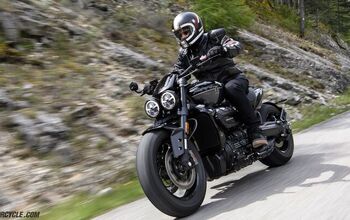"More Proficient Motorcycling" Book Review
In the seven years since “Proficient Motorcycling” was first published, it has become the book of record regarding street riding skills.
Motorcycle.com reviewed this book when it was first published in 2000, so I’m not going to re-pave that review. Instead, I’ll offer a brief personal road test of “Proficient Motorcycling” and its devilishly cleverly titled sequel: “More Proficient Motorcycling.”
Let’s jump right in. I would like you to turn to page 149 in your “Proficient Motorcycling” texts. In the photo on the top right of the page you will see a classic edge trap. It was on this page that this book paid for itself.
I was riding to work via my usual route, my helmet filled with the usual inner monologue about poisonous cone snails when I noticed a new sign. It read: Construction. Within two feet of the sign the pavement ended and I sailed off the edge of the map. My wheels touched down in soft gravel, and while the front tire squirreled about I noticed I was going to have to crab up a tall steep lip of pavement to get out of this mess. For bonus stress, the car behind me was attempting to probe my exhaust system.
The inner Hough reminded me to take on the edge at greater than a 45-degree angle. I swung out, got up on the pegs, shifted my weight back and gave her some throttle to get the front wheel up and onto the pavement.
That’s it – a boring non-story. No crash, no hospital visit, nix repairs. I wonder how many non-stories like this have been told thanks to this book. Seems a bit of an unfair pedestrian legacy for Mr. Hough...
“Proficient Motorcycling” covers a lot of ground. The beginning is devoted to risk, and a refreshingly well-written chapter follows about the physics behind riding – exactly why does a motorcycle have to lean to negotiate a curve? This is not information for information sake, as riding exercises (similar to those taught in MSF courses) put the physics in motion in the following chapter titled “Dynamics.”
In the previous MO review umbrage was taken with cornering techniques that Hough advocates. A delayed apex may not be the fastest route around a curve, but it is the safest.
You will probably find a riding exercise in this book you need to work on. My nemesis is U-Turns. I hate them and I don’t want to do them. But “the bottom line is, whatever skills we find difficult are the ones we need to practice.”
It is obvious that Mr. Hough lives in a harsher clime than Southern California, as a good bit of attention is given to topics like hypothermia, traction control in freezing weather, and rain-riding tactics. Don’t worry, though, if you are a SoCal softie. Urban Blighters will be sated by details about dehydration, intersections from hell and road rage.
Because “Proficient Motorcycling” began as a series of articles, it does tend to give a choppy flow to the book. But when you come to the end, I would be surprised if you don’t want more. More? Wait! There is More!
“More Proficient Motorcycling” By David L. Hough
Bowtie Press
Copyright 2003
256 Pages with B&W Photographs.
“Please, sir, I want some more.”
Oliver Twist, Charles Dickens
The prime sin of the father is delivered upon the son when it comes to “More Proficient Motorcycling.” Sin? Yes indeed. Both books share an egregious flaw that you will discover when you crack them open the first time. The cracking sound you will hear is the sound of the spine (binding) breaking. Both books then commence shedding pages like a Labrador in springtime.
If you haven’t gathered it by now, I am a huge fan of Hough’s books. The fact I have to keep them together with rubber bands is a travesty. Bowtie, the publisher, needs to stuff a few more Preakness losers into the glue pot and set the friars to binding these books properly. Dickens wouldn’t have put up with this @#%*.
(After the initial posting of this story, the publishers of "MPN" responded with the following: "Sorry to hear that you got the printing with the bad glue. Newer printings have a stitched binding and will be much harder to rip apart. So sell your stock in rubber band companies.")
While “More Proficient Motorcycling” will stand on its own, it really is best approached as a supplement to the original. In “MPM,” you get your Hough daily allowance of traction topics, including gravel, oil, slippery goo, cattle guards and – my favorite – tar snakes. One area where you certainly find “More” is on the topic of braking. There are exercises for quick stops in curves.
And about curves – oh yes – he couldn’t leave the delayed apex well enough alone. You will also find more about countersteering, bodysteering and other associated body English. It is a pity there is no body French in this book, however.
The mental aspects of the ride are explored, as is our attitudes (universally bad, I expect) that help or hinder. Booze? Three bags full! Oh, wait. No, I am riding today. Now what about the siren song of speed? Damn the torpedoes! Hough agrees! Well, no, actually he doesn’t. He at least notes that increased speed is not necessarily proportional to increased risk. This is further tempered by a frank discussion about skill and rider training (or lack thereof) both here in the U.S. and in lands of Metric persuasion.
Earlier I related that I was surprised by a construction zone that sprung up on my usual route. Hough repeatedly hammers on the importance of getting your mind in the ride – something I failed to do that day. In order to get the most out of these books you have to be honest in your assessment of your skills and personal liabilities. One last time: mature audiences only. I had more wicked good points to make about this, but unfortunately I was distracted by a shiny object.
'The mental aspects of the ride are explored, as is our attitudes that help or hinder.'
The competitive behavior inherent in riding is addressed, and some tactics are offered for what to do when a squid kicks sand in your face. Shoot the bastard is not one of the options listed, unfortunately. Actually, while it is not a suggested remedy for the competitive amongst us, I found the detailed instructions to setting up a cornering course quite interesting. Hough relates that your skills at low speed can indicate a good deal about your skill at higher velocities.
I suspect the cornering exercise would provide a nice way to deal with your neighbor. You know the one – we will call him the Artful Dodger. He bought his Goldwing a month after you got yours (and he claims to have paid $944.67 less for it). This rivalry is long simmering. It goes all the way back to him strutting about with his Lone Ranger lunchbox.
And what tramples your rhubarb about him is his skill at low speed on the Wing. He oozes smarmy confidence as he slinks his way about the neighborhood. The showdown is inevitable on the field of battle illustrated on page 121. You smile as you envision him soiling his ’Stitch as he cripples his Wing. You can even have the perfect words of condolence delivered before the rear wheel stops spinning: “Don’t worry about it. A new fairing will only cost you $945.67. Would you like the part number?”
“More Proficient Motorcycling” concludes with 10 tips that can save your life.
You will find both sides of experience in these books – what to do as well as what not to do. At a minimum these books will make you think about – and perhaps even defend – your riding habits. For that reason they deserve to be on your mental shelf. I have made mental space for my inner Hough, even though my mental space is already crowded. However, I doubt I will regret evicting Mr. Screamslikeagirl and Panic Boy from my mental reverie.
I found these books difficult to review. They are on the road to becoming “classics,” which is heady stuff. I usually enjoy goring other people’s favorite oxen. Unfortunately these books are all that and a bag of chips. At times I found Hough’s books to be dark in tone, but then again, I needed to have some of the sunshine slapped out of me.
My recommendation: buy them both (and a bag of rubber bands).
More by Leif Merryfield



























Comments
Join the conversation